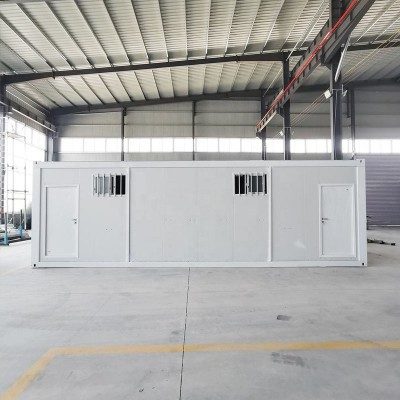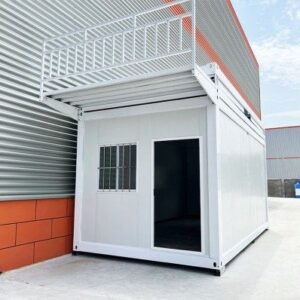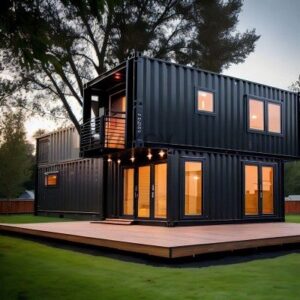Step-by-Step Construction Process for How to Build a House Using Shipping Containers
Building a shipping container home involves several key steps you want to follow to ensure a solid, safe, and comfortable structure. Here’s a breakdown of the container home construction process, focusing on assembly, insulation, utilities, and finishing touches.
Assembling Containers On Site
- Position and Stack Containers: Start by placing the containers on your prepared foundation. Depending on your design, containers might be placed side-by-side or stacked vertically. Proper alignment is critical.
- Welding and Securing: Weld the containers together to create a seamless, stable structure. This welding connects corners and edges, ensuring safety and rigidity.
- Reinforcement: Additional steel supports may be added if your design requires large openings or multi-story stacking.
Installing Doors, Windows, and Insulation
- Cutting Openings: Use plasma cutters or saws to carefully cut doors and window openings. Proper framing is essential to maintain the structural integrity of the container.
- Installing Doors and Windows: Use pre-fabricated doors and windows designed for container homes or modify standard ones to fit.
- Insulation Installation: This is vital since metal containers can get hot or cold quickly. Common insulation options include:
- Spray foam insulation — creates an airtight seal, great for thermal efficiency.
- Blanket insulation — fiberglass or mineral wool panels, easier to install.
- Rigid foam boards — moisture-resistant and durable inside container walls.
Electrical Wiring and Plumbing Basics
- Electrical Setup: Plan wiring layouts before wall coverings go up. Normally, wiring runs through conduit channels welded or attached inside the container walls.
- Plumbing Installation: Plumbing is usually set externally or through raised floors. Use materials fit for container homes, such as PEX piping, to resist corrosion.
- Both systems must comply with local building codes and inspections.
Interior Finishing Ideas
- Drywall and Wall Coverings: Once insulated and wired, drywall or wood paneling goes up. This hides insulation and wiring while improving aesthetics.
- Flooring Options: Popular choices include polished concrete, hardwood, or laminate floors, depending on your style and budget.
- Ceiling Treatments: Options range from exposed beams for an industrial look to drywall or wood panel ceilings for warmth.
- Painting and Decorating: Choose light colors for a spacious feel or bold colors for character.
Roofing Options for Container Houses
- Flat Roofs: Common for container homes, allowing for solar panel installation or green roofs.
- Sloped Roofs: Added to improve rain runoff and interior volume.
- Roof Coatings: Reflective coatings reduce heat absorption, boosting energy efficiency.
Following these steps carefully will help turn your shipping containers into a functional, comfortable home. For more tailored container types and design ideas, check out modern container house options and 40-foot container house models.
Shipping Container Homes What is a Shipping Container Home
A shipping container home is a residential structure built by repurposing durable steel shipping containers. These containers, originally designed to transport goods globally, offer a solid and modular base for building homes that are affordable, eco-friendly, and customizable. Using shipping containers for home construction allows for faster builds and a unique architectural style that stands out from traditional houses.
Types and Sizes of Shipping Containers Commonly Used
The most popular containers for home building are 20-foot, 40-foot, and 40-foot high cube shipping containers. Each size offers distinct advantages depending on your design needs:
- 20-Foot ContainersMeasure roughly 20 feet long, 8 feet wide, and 8.5 feet tall. These are easier to maneuver and ideal for small-scale projects or rooms like bedrooms and bathrooms.
- 40-Foot ContainersTwice as long as 20-foot containers, these are popular for larger living spaces or combining multiple rooms side by side.
- 40-Foot High Cube ContainersSimilar length and width as standard 40-foot containers but with an extra foot of height (about 9.5 feet tall), providing more vertical space and improved comfort, especially for living areas.
Pros and Cons of Building with Shipping Containers
Pros
- Durability and strength: Designed to withstand harsh ocean conditions, these containers are robust and long-lasting.
- Speed of construction: The basic shell is ready, saving weeks or months on framing.
- Cost-effectiveness: Containers can be more affordable than traditional building materials.
- Modularity and flexibility: Easy to stack, combine, and transport.
- Eco-friendly option: Recycling shipping containers reduces waste and demand for new materials.
Cons
- Insulation challenges: Metal containers require careful insulation to manage heat and cold.
- Permitting and building code issues: Not all areas readily approve container homes without special permits.
- Size constraints: Standard container widths can limit interior space without additional modifications.
- Modification complexity: Cutting openings and reinforcing structural integrity requires expert skills and may increase cost.
- Potential for rust and corrosion: Containers need thorough treatment and maintenance to avoid deterioration over time.
Understanding these basics helps you decide if building a home from shipping containers fits your lifestyle and project goals. This foundation prepares you for planning, budgeting, and the unique steps involved in container home construction.
Planning Your Container Home with Shipping Container Home Design Ideas and Regulations
When it comes to planning your container home, getting clear on your needs and project scope is the essential first step. Think about how many people will live in the house, what rooms you require, and how flexible you want the space to be. Shipping container homes vary widely in size and customization, so defining this early helps streamline design and budgeting.
Assess Your Needs and Define Project Scope
- Identify your lifestyle requirements: Number of bedrooms, bathrooms, workspace, and common areas.
- Determine future flexibility: Would you want to add more containers or expand later?
- Set realistic space expectations: Containers are compact, so space optimization is key.
- Decide on style and comfort level: Minimalist, modern, rustic, or fully finished interior.
Design Considerations and Space Optimization
Because containers are narrow and long, designing for maximum usability within limited square footage is vital:
- Open floor plans can make the interior feel larger.
- Stacking containers vertically or arranging around a courtyard creates more space and privacy.
- Use multi-functional furniture to save room.
- Plan windows and doors carefully to increase natural light and ventilation without compromising structural integrity.
- Consider how often you’ll use outdoor spaces to extend livable areas.
Choosing the Right Containers Based on Design
The common sizes are 20ft and 40ft containers, with the 40ft high cube offering about a foot more headroom, which can make a big difference in comfort.
- 20ft containers: Ideal for small studios or single-room builds.
- 40ft containers: Better for larger homes or combining multiples.
- High cube containers: Provide extra ceiling height, crucial for comfortable living spaces.
- Choose between new or used containers depending on budget and quality preferences.
Understand Local Building Codes Zoning Laws and Permits
Before investing, make sure to:
- Check local zoning regulations: Some areas restrict or have guidelines on container homes.
- Obtain necessary permits: Building, electrical, plumbing, and occupancy permits are often mandatory.
- Consult with your city or county building department early to avoid surprises.
- Consider hiring a professional familiar with container home regulations to speed up approvals.
- Understand foundation and safety requirements specific to containers.
Handling permits correctly ensures your container house conversion process goes smoothly without costly legal issues.
For more detailed container home designs and requirements, you might find YC Container House’s resources helpful to get practical ideas and regulatory insights tailored for U.S. customers.
Budgeting for Building a Shipping Container House Costs and Tips
When you’re building a house from shipping containers, budgeting is a crucial step. The total cost depends on several key factors, including the price of containers, foundation work, insulation, modifications, and labor. Knowing what to expect helps you avoid surprises and keeps your project on track.
Typical Costs Involved in Shipping Container Home Construction
Here’s a breakdown of the main expenses you’ll face:
- Shipping Containers
- New 20ft container: $3,000 to $5,000
- Used 20ft container: $1,500 to $3,000
- New 40ft container: $5,000 to $8,000
- Used 40ft container: $2,500 to $5,000
- Foundation
- Simple pier foundation: $2,000 to $5,000
- Concrete slab foundation: $5,000 to $15,000 (depending on size and site)
- Insulation
- Spray foam insulation: $2 to $4 per sq ft
- Blanket or panel insulation: $1 to $2.50 per sq ft
- Modifications (cutting openings, welding, reinforcing)
- Can range from $5,000 to $15,000 or more depending on design complexity
- Labor
- Skilled labor for welding, electrical, plumbing, and finishing typically runs $40 to $70 per hour or contractor quotes vary widely
Ways to Save Money on Your Container Home Build
- Choose used containers over new when condition allows
- Limit structural changes to reduce welding and cutting costs
- Do some work yourself if you have DIY skills, especially interior finishing
- Buy materials locally to cut down shipping fees
- Plan carefully to reduce changes during construction that increase costs
Example Budgets for Different Sized Container Homes
| Home Size | Approx. Container Count | Estimated Budget Range | Notes |
|---|---|---|---|
| Small (1-2 bed) | 1-2 (20ft or 40ft) | $30,000 to $60,000 | Basic foundation, minimal mods |
| Medium (3 bed) | 3-4 (40ft containers) | $60,000 to $120,000 | More extensive insulation and finishes |
| Large (4+ bed) | 5+ containers | $120,000 to $250,000+ | Complex designs, premium materials |
Budgeting well in advance helps you tackle each phase confidently. Understanding costs related to container home insulation methods, foundation types, and container modifications lets you plan realistically, saving time and money in the long run.
Preparing and Modifying Shipping Containers for Your Home
Sourcing Shipping Containers New or Used Where and How to Buy
When building a house from shipping containers, the first step is choosing your containers. You can buy new or used containers depending on your budget and needs.
- New containers cost more but come in perfect shape with no previous wear or rust.
- Used containers are cheaper and widely available but may need repairs or rust treatment.
- Popular places to buy include local marine yards, online auctions, and container dealerships.
- Always ask about the container’s history, such as if it carried hazardous materials.
Inspecting and Preparing Containers Cleaning Rust Treatment
Before you start modifying, inspect each container thoroughly:
- Look for rust spots, dents, large holes, or structural damage.
- Ensure the container is dry and free of mold or chemicals.
- Clean the containers inside and out.
- Treat rusty areas by sanding down rust spots, then apply a rust converter and protective primer.
- Apply a fresh coat of weatherproof paint to seal and protect the metal.
Modifications Cutting Openings Doors Windows Welding Structural Reinforcements
To turn a container into livable space, you’ll need to modify its steel shell:
- Cut openings are necessary for doors, windows, and ventilation.
- Use plasma cutters or angle grinders for clean cuts.
- After cutting, weld on steel frames to reinforce the structural integrity around openings; containers rely on their steel walls for strength, so reinforcements are critical.
- Adding extra steel beams or columns might be needed if stacking or joining multiple containers.
- Be sure all welds and cuts meet local building codes and safety standards.
Insulation Types and Strategies for Shipping Container Homes
Container homes require efficient insulation to stay comfortable in US climates. Popular options include:
- Spray foam insulation: Offers excellent air sealing and R-value; great for tight spaces.
- Blanket insulation (fiberglass or mineral wool): More affordable but needs proper vapor barriers.
- Rigid foam panels: Durable and moisture resistant; often used on exterior or roof.
- Combination approaches: Many builders use spray foam inside walls and rigid foam outside.
- Pay special attention to thermal bridging, where steel transfers heat or cold; insulating continuous barriers helps prevent this.
Foundation and Site Preparation for Shipping Container Homes
Suitable Foundation Types for Shipping Container Homes
When building a home from shipping containers, choosing the right foundation is crucial. The foundation supports the weight of the containers and ensures stability. Common foundation types for container homes include:
- Pier Foundation: Concrete piers are poured at specific points to hold container corners and midpoints. This is cost-effective and allows good airflow beneath the home.
- Slab Foundation: A solid concrete slab provides a flat, stable base, great for heavier container homes or multiple stacked units. It also helps with insulation and moisture control.
- Crawl Space Foundation: Raised foundation with open space underneath. It protects against ground moisture and can simplify plumbing or electrical access.
Each foundation type has its benefits, and deciding depends on your soil type, local climate, and budget.
Site Clearing and Leveling Essentials
Before placing containers, the building site must be properly prepared. This involves:
- Clearing vegetation, rocks, and debris.
- Leveling the ground for an even base, which is necessary to ensure containers fit together tightly and remain structurally sound.
- Compacting soil to prevent future settling that can shift your foundation or containers.
Proper site prep prevents future structural problems and saves money on costly repairs.
Importance of Drainage and Moisture Control
Managing water around your container home is critical. Shipping containers are steel, so they’re prone to rust and corrosion if exposed to standing water or excessive moisture. To protect your investment:
- Plan for effective drainage systems around the foundation site to direct rainwater away.
- Consider installing French drains, gutters, or swales to prevent water buildup.
- Use waterproof barriers between the container base and foundation to reduce moisture wicking.
- Make sure the foundation design includes proper grading so water naturally flows away from the home.
Taking care of drainage and moisture upfront reduces the risk of rust, foundation damage, and mold inside your shipping container home.
Energy Efficiency and Sustainability in Shipping Container Homes
Building a shipping container home isn’t just about a unique look; it can also be a smart move for energy efficiency and sustainability. Shipping containers reuse steel structures, which reduces demand for new building materials. Plus, with the right design and systems, these homes can be very eco-friendly.
How Container Homes Promote Sustainability
- Material reuse: Shipping containers are repurposed steel boxes, so using them cuts down on new construction materials like wood and concrete, lowering your environmental footprint.
- Reduced construction waste: Since containers come in standard sizes, onsite waste from cutting and framing is minimized.
- Durability: Containers are designed to withstand harsh conditions, giving your home a long lifespan with less frequent repairs.
Incorporating Renewable Energy in Container Homes
To make your container home truly sustainable, pairing it with renewable energy options is an excellent idea:
- Solar Panels: These are a popular choice in the U.S. for container homes. Roof-mounted solar panels can generate enough electricity to power your home, especially with energy-efficient appliances.
- Wind Turbines: In windy areas, small turbines can complement solar power for off-grid setups.
- Rainwater Harvesting: Installing gutters and storage tanks allows you to collect rainwater for irrigation or gray water use, reducing dependence on municipal water.

Ventilation and Natural Lighting for Energy Savings
Good airflow and natural light reduce the need for artificial heating, cooling, and lighting:
- Ventilation: Properly placed vents and windows help air circulate, preventing moisture buildup and reducing cooling costs in warm months.
- Natural Lighting: Adding large windows, skylights, and light tubes makes the interior brighter during the day, cutting down on electricity use.
- Placement: Orient your container home to maximize southern exposure for solar gain in colder months and minimize heat during summer.
Additional Energy Efficiency Tips
- Insulation: Use spray foam or blanket insulation tailored for metal homes to control temperature and prevent thermal bridging.
- Energy-Efficient Appliances and LEDs: Opt for Energy Star-rated products to keep electricity use low.
- Green Roofs or Shading: Adding a green roof or shade structures can reduce heat absorption and improve insulation.
By combining the inherent strength of shipping containers with smart energy systems and design, you can build a sustainable shipping container home that’s both cost-effective and environmentally responsible.

